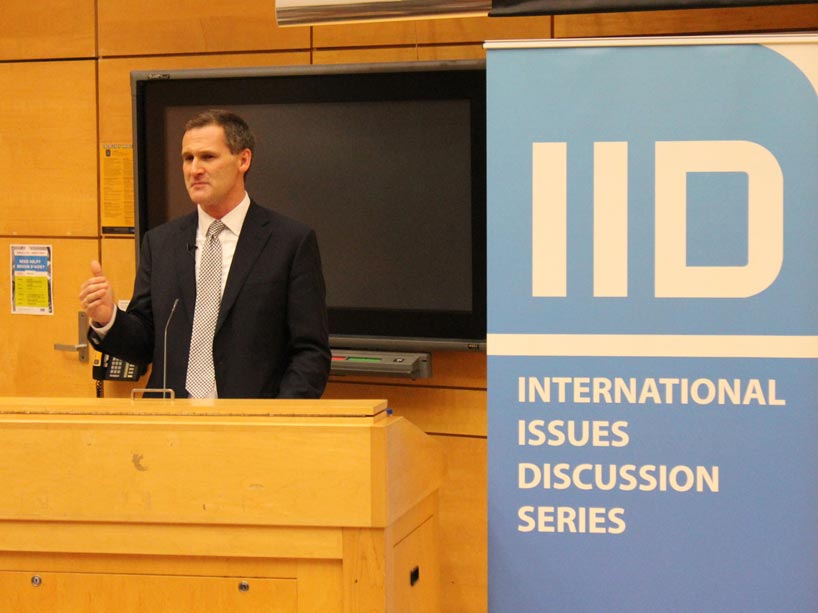What is the real Charlottesville?

Photo: Michael Signer, mayor of Charlottesville, Virginia, discussed “Democracy in the Age of Trump” at Ryerson on November 29.
You have heard that Charlottesville, Virginia, became the site last summer of a far-right rally with hatred and violence heard around the world. You may not have heard why the city was a target. On November 29, Charlottesville mayor Michael Signer visited campus as part of the International Issues Discussion series through the Department of History—discussing governing under the cloud of Donald Trump, and addressing misconceptions about the city he calls home.
In a talk titled “Democracy in the Age of Trump” at the George Vari Engineering and Computing Centre, Signer began by painting a picture of Charlottesville that is very different from the one in last summer’s media: a progressive city (Bernie Sanders won its Democratic primary, and Hillary Clinton won the general election with 79.7 per cent) in the midst of a painful reckoning with its past. “It was a good thing that we started the project of a progressive southern city lifting the veil and telling the full truth of race in our past,” said Signer. “But that is what made us a target for these outside groups that didn’t want that project started.”
Charlottesville launched “Dialogue on Race,” a city-wide series of conversations among citizens with the aim to generate a policy agenda. This led directly to initiatives including an office on human rights and programs to re-integrate ex-offenders into society. More recently, the city has struggled over a statue of Confederate general Robert E. Lee, which was installed in downtown Charlottesville during the Jim Crow 1920s. This was one of many Civil War memorials built in the south decades after the Civil War, intending to both promote a romanticized “lost cause” narrative around the Confederacy and to send a veiled message to civil rights activists.
An existing law prevented the removal of war memorials, so city council instead created the Blue Ribbon Commission on Race Memorials and Public Spaces—a group of nine citizen members (a majority African-American) tasked to “advise city council on changing the narrative in Charlottesville by telling the full story of race through public spaces.” Their prescriptions addressed not only the Confederate monuments, but also underfunding of public resources and second-class treatment of Black neighbourhoods. “We ended up acting on virtually every one of their recommendations,” said Signer—including renaming Lee Park as “Emancipation Park” and altering statues’ plaques to address the neo-Confederate movements that built them.
The renaming of the park and the controversy surrounding the statue made Charlottesville a target for the likes of Richard Spencer and the Unite the Right rally. “The intent of the organizers was that this was going to be Alt-Right 2.0,” said Signer. “They said, ‘This is going to be the moment where the world sees our movement and really reckons with us for who we are.’” What followed is well-known: a disastrous spectacle of hatred and violence that culminated in the death of a counter-protester.
Signer noted that most of the alt-right protesters came from out of town, egged on by leaders like Richard Spencer. “They did not want to change the narrative,” said Signer. “They did not want the full story told about race in this country. Remember, what they wanted was embodied in the slogan, ‘Make America Great Again’—which means that everything in that idea of greatness has already been established. ‘There is no more work to be done, we must return to the past, and the narrative does not mean to be changed.’”
Signer did not hesitate to credit the Trump administration with making the rally possible. “My take on this is that these groups were always in the shadows. You had the John Birch Society, you had the KKK, you had separatists, you had militia movements, you had racist biker gangs, you had a lot of these different organizations. But there really was a devil’s bargain that the Trump campaign and Breitbart news and the nascent alt-right movement struck with these forces. It was a base political strategy to intensify enthusiasm and turnout politically.”
Signer drew parallels between Trump and the tyrants he described in his 2009 book Demagogue: The Fight to Save Democracy from its Worst Enemies, but concluded the event on a note of optimism. Citing the landslide victory of Ralph Northam in Virginia’s recent governorship election and the wave of anti-Trump activism, he called for a return to civic engagement.
“All of that depended on agency: on people deciding to do something. It depended on people deciding to do something. And I saw it every day in Charlottesville. There was no wave that was happening around people: it was people like you all deciding to do something different as a result of what they were seeing. All that action was voluntary and it was based on an idea of what American democracy was.”